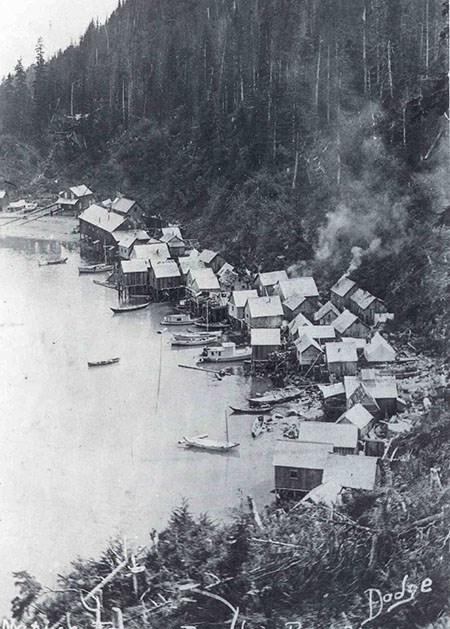Part of a series of articles titled Canneries of Alaska.
Previous: Bartlett Cove Canneries
Next: Kukak Bay Cannery
Article

NPS / Glacier Bay National Park & Preserve Archives
The facility initially consisted of a small hand operation capable of producing 300 cases per day. In 1900, the cannery employed 96 workers, including 26 native fishermen and 26 native cannery workers. Most of the Native Alaskan fishermen used company-owned gear and were paid by the fish. They fished primarily in Dundas and Taylor Bays, Cross Sound around Cape Spencer, Glacier Bay, Excursion Inlet, and the Alsek River delta.
By 1912, a small Native Alaskan town had developed adjacent to the cannery buildings. Historical photographs of the town show small houses and ancillary buildings, mostly built on pilings, clustered along the shore of the sheltered inlet north of the cannery. Unlike the large communal houses found in traditional villages, the small houses constructed adjacent to the cannery were likely occupied by a single nuclear or extended family. The photos also show a variety of boats, including traditional dug-out canoes as well as dories and vessels with enclosed cabins, beached in front of the houses or anchored in the bay in front of the buildings. This was a critical period of transition for this aspect of traditional Tlingit culture – it was at this time that dugout canoes rapidly gave way to plank boats, and as soon as gas engines arrived, the era of the canoe was over.
The cannery changed hands in 1901, when the Pacific Packing and Navigation Company purchased the plant and added a mechanized processing line. In 1905, the Northwestern Fisheries Company bought the Dundas Bay facility and continued to operate the cannery until 1931. In 1932, the Northwestern Fisheries Company sold the plant to Pacific American Fisheries, but the new owner never reopened it. With the closing of the cannery, most of the Native Alaskan workers relocated to the village of Hoonah on Chichagof Island. However, they continued to use Dundas Bay on a seasonal basis for traditional subsistance practices of harvesting and preparing resources.
| Year | Event | Owner | Pack |
|---|---|---|---|
| 1900 | Cannery built | Western Fisheries Company | 300 case per day |
| 1901 | Sold; mechanized processing line | Pacific Packing and Navigation Company | - |
| 1905 | Sold | Northwestern Fisheries Company | - |
| 1912 | Native Alaskan Village develops adjacent to the cannery | Northwestern Fisheries Company | - |
| 1931 | Plant closed | Northwestern Fisheries Company | - |
| 1932 | Sold; never reopened | Pacific American Fisheries | - |

NPS
Kurtz, Rick S. Glacier Bay National Park and Preserve Historic Resource Study. Anchorage: National Park Service, Alaska System Support Office, 1995.
Langdon, Steve. "From Communal Property to Common Property to Limited Entry: Historical Ironies in the Management of Southeast Alaska Salmon:” In, A Sea of Small Boats, J. Cordell, editor. Cultural Survival, Inc., Cambridge. 1989.
Part of a series of articles titled Canneries of Alaska.
Previous: Bartlett Cove Canneries
Next: Kukak Bay Cannery
Last updated: November 5, 2019